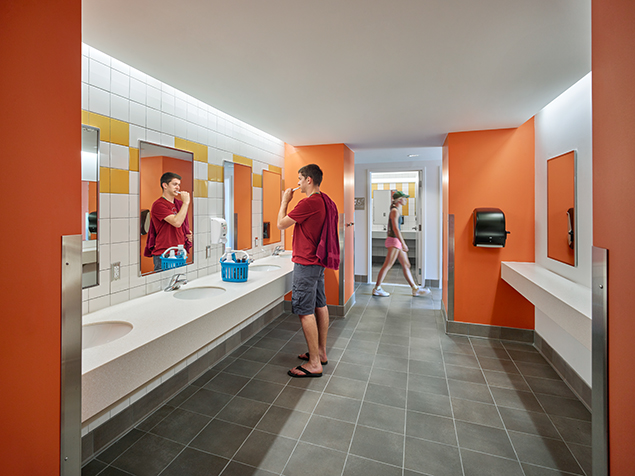News & Insights
Fixture Flexibility - Creative Moderation of Bathroom Plumbing Fixture Counts
February 9, 2022
Building and plumbing codes determine occupant loads and fixture quantities. As simple as that sounds, it’s not always a straightforward proposition. The following article examines multiple factors that can impact plumbing fixture counts and provides examples to illustrate the nuances that can determine what your future project may need.

Plumbing Fixture Count – An Invariable Mandate?
An examination of code requirements setting a building’s minimum plumbing fixture count initially suggests a straightforward and rigid process: The building code dictates the number of occupants in the building, and then the plumbing code dictates the number of fixtures required, based on that occupant load. Like many other aspects of the code, however, an apparently finite requirement can become subject to interpretation when the nuances of the building’s actual use are introduced.The International Plumbing Code utilizes a table to assign minimum fixture counts based upon the use of the building, and the number of occupants who will use it. For example, a church must have one Water Closet (WC) for every 150 male occupants, and one WC for every 75 female occupants. Many other building uses are listed, each with similar fixture ratios. As such, calculating the required fixtures for a given function first necessitates the establishment of the building’s occupant load. The fixture table in the International Plumbing Code is prefaced by this statement: “The number of occupants shall be determined by the International Building Code”.
Turning to the building code, a similar table determines occupant load in accordance with building functions. For example, a classroom is calculated to have one occupant for every 20 square feet of space. A library reading room is assigned one occupant for every 50 square feet, and so on. Therefore, by establishing a building’s use and occupant load using the building code, the required plumbing fixture count can be concluded via the corresponding table in the plumbing code.
Fixture Moderation
In all but the most straightforward of buildings, exceptional circumstances are bound to arise when calculating the occupant load and required plumbing fixture counts. Sometimes, strict adherence to code ratios can result in fixture counts which seem unreasonably high, in consideration of how the Owner actually plans to use the building. Following are several examples in which such situations can be creatively resolved through careful consideration, communication, and reasoned collaboration with code officials.
Occasional Change in Use
While designing a large gymnasium for a university recreational center, the design team was informed by the client that they intended to use the space very infrequently—perhaps once or twice a year—to host large assembly events such as convocations. This significant change in use would suddenly balloon the building’s occupant load from a few hundred to several thousand. The resulting escalation in required fixtures for the public restrooms seemed an unnecessary hardship, considering that the space would only be used for large events on a very infrequent basis. The design team proposed to the code official that—while all of the building’s life safety features would be provided in accordance with the higher occupant load—the HVAC system would be sized, and plumbing fixture count would be derived, from the lower occupancy. Collaborative discussions between the university, the architect, and the building official resulted in written approval of the proposed solution.Non-Concurrent Occupancy
In many instances, buildings are designed to accommodate multiple functions which may in fact be utilized by only one group of occupants. For example, an office building may include large conference rooms which are intended to be used only by the people who already work in the building. But, calculating occupant load in each space demands that the occupants of the offices must be added to the occupants of the conference rooms—a condition that would not occur in actual practice. While stressing that the building’s life safety and egress components must always be designed to accommodate the combined load, code officials have the discretion to permit flexibility on plumbing fixture counts in such situations. In this example, the code official may allow fixtures to be provided in accordance with the office load only.
Building Official Exception
In order to provide accessible, modernized, and gender-neutral bathrooms to serve a mixed-gender building, a university client asked the design team to renovate a 1960’s-era dormitory such that the former gang-style bathrooms would be converted into a grouped core of individual, privatized bathrooms. Each would contain a single toilet, sink, and shower. A reconfiguration of this type within the same footprint—as one may expect—resulted in an overall reduction in fixture count from the original gang arrangement. When checking to confirm if the lower count was still in compliance with the occupant load, the architect found that the “dormitory” use group is calculated at one occupant per 50 square feet, resulting in a calculated occupant load of 200. At a code minimum ratio of one shower per eight occupants, this would have resulted in the dormitory needing 25 individual privatized bathrooms per floor: far above the actual need. The architect then turned to bed count; the actual number of beds on each floor is 78. At one shower per eight occupants, the bathroom count is significantly reduced to the more reasonable quantity of 10 per floor. In this case, the architect employed an exception that prefaces the occupant load calculation table:“Where approved by the building official, the actual number of occupants for whom each occupied space, floor, or building is designed, although less than those determined by calculation, shall be permitted to be used in the determination of the design occupant load.”
The drawings for the project clearly state that the occupant load applied for life safety purposes is the higher number, 200, while the occupant load applied for plumbing fixture purposes is derived from the bed count, 78. This is clearly in compliance with the above-referenced exception: The building official is being asked to approve that the “actual number of occupants”, is “less than those determined by calculation”. This exception, while employed in the dormitory illustration, is equally applicable to the previous examples of the gymnasium and the office building.
It is important to reiterate that at no point should an owner or architect ever attempt to “sneak one past” the code official. In each example described above, the life safety drawings clearly stated and illustrated the strategy being employed, and quoted the intent to apply the building official’s discretion in approving an occupant load that would be lower than if strictly calculated. The code official’s approval of an architect’s drawings does not relieve the architect from responsibility to comply with code, or from litigation if they have not done so. In some cases, the architect contacted the local authority and received written approval to apply these provisions ahead of time.
Additions and Renovations
There are also relevant strategies that can be applied concerning accessibility requirements, particularly in existing buildings. In interior renovation projects, the International Existing Building Code (IEBC) requires that the fixture count of the existing toilet rooms be increased only if the building occupant load grows by more than 20 percent. Accessibility codes may require toilet room upgrades to meet current accessibility guidelines, depending on the extent of the renovation work. But if the occupant load does not expand, the fixture count does not require expansion either.In another unique situation, an existing building was being enlarged via the construction of a significant addition, however, there was no intent for the project to include a renovation of the existing building that was to remain. Here, the occupant load was clearly being increased considerably, but the Owner had no desire to renovate the existing non-accessible toilet rooms. Through communication with the ADA technical assistance office, the architect was able to confirm that upgrades to the existing toilet rooms would not be necessary as long as the fixtures in the non-compliant bathrooms did not contribute toward the required fixture count. The new addition was constructed with new, fully compliant toilet rooms that included the full count for the entire facility; the existing building plus the new addition. The older toilet rooms remained unchanged. The final project, therefore, included many more fixtures than necessary, but it was determined providing all-new fully compliant bathrooms was less costly than attempting to surgically renovate the bathrooms in the older building.

